Coordinates: 12°18′50″N76°37′20″E / 12.3139265°N 76.6222273°E
Contents

Jayalakshmi Vilas Mansion is a heritage building in Mysore.
Coordinates: 12°18′50″N76°37′20″E / 12.3139265°N 76.6222273°E

Jayalakshmi Vilas Mansion is a heritage building in Mysore.
Jayalakshmi Vilas Mansion is a building of architectural importance in Mysore city, Karnataka. It is located in the verdant surroundings of Manasa Gangothri, the campus of the University of Mysore. It rises on a hillock on the west side of Kukkarahalli Kere (lake). Jayalakshmi Vilas Mansion houses a museum of priceless collections of artifacts. The Karnataka government classifies it as a heritage structure.
The mansion was built in 1905, during the period of Krishnaraja Wodeyar IV, for princess Jayalakshmi Ammani, the eldest daughter of the Maharaja Chamaraja Wodeyar, at a cost of Rs. 7 lakhs. The location was intentionally chosen to be on top of a small hillock above Kukkarahalli Kere(lake). It was originally called 'the First Rajkumari Mansion'. The first princess Jayalakshmi, was married to Sirdar M. Kantharaj Urs in 1897, who later became the Dewan of Mysore. Kantharaj Urs had a house in the Fort of the Palace called "Gunamba House" after his mother. The mansion was built to be commensurate with their status of princess and dewan.
The mansion was gifted by the Maharaja of Mysore, Jayachamaraja Wodeyar, to the University of Mysore to establish a postgraduate center in its campus.
The building was in a state of neglect for a very long time. The building was restored at a cost of Rs. 1.17 crores with funds from the Infosys Foundation. Renovation began in 2002 and were completed in 2006. It was inaugurated by the governor of Karnataka on 16 January 2006 by switching on this new illumination system.
The renovated mansion has 125 rooms, 300 windows, 287 exquisitely carved doors and it was spread across 6 acres (24,000 m2). There are entrances on each side, different from each other. The entrance on the northern side has an extrusion on the stairs presumably to be used as alighting platform from cars and chariots. The mansion is chiefly built of brick and mortar, timber and iron. Stone was dispensed with considering the amount of delay it would have on construction if it were used. There are separated drainages for rain water and used water.

Mysore, officially Mysuru, is a metropolitan city in the southern Indian state of Karnataka. It is the third-most populous and third-largest city in the state, and is one of the cleanest cities in India. It is the seat of the Wadiyar dynasty and was the capital of the Kingdom of Mysore for almost six centuries, from 1399 until 1947. It is currently the headquarters of Mysore district and Mysore division. Known for its heritage structures and palaces, including the famous Mysore Palace, and noted for its culture, Mysore is popularly known as the "City of Palaces", the "Heritage City", and the "Cultural Capital of Karnataka". For its pristine and calm ambience, it is also known as "Pensioners' Paradise".

Srirangapatna is a town and headquarters of one of the seven Taluks of Mandya district, in the Indian State of Karnataka. It gets its name from the Ranganthaswamy temple consecrated at around 984 CE. Later, under the British rule the city was renamed to Seringapatnam. Located near the city of Mandya, it is of religious, cultural and historic importance.
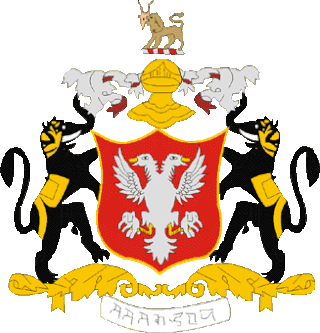
The Wadiyar dynasty, is a late-medieval/early-modern South Indian Hindu royal family of former kings of Mysore from the Urs clan originally based in Mysore city.

Kukkarahalli Lake also called Kukkarhalli Kere, located in the heart of the Mysore city, adjoins the Manasgangotri, the Kalamandir (Rangyana) and the Central Food Technological Research Institute (CFTRI) campus. It provides lung-space to the city. Mummadi Krishnaraja Wodeyar (1794–1868) of the Mysore dynasty was responsible for getting the lake created, in the year 1864, to provide water for irrigation to about 4000 ha of land outside the city. The Lake also used to be a source of water supply to the city of Mysore but over the years, sewage and excessive land encroachments and blockage of water flow sources almost led to the eutrophication of the lake. The University of Mysore and the citizen forums of Mysore continue to make efforts to preserve the lake by implementing several remedial measures. There is a 3.5-km walkway on the periphery of the lake with shaded stone benches for visitors to sit, relax and enjoy the scenic serenity of the lake.

Chamarajendra Wadiyar X was the twenty-third Maharaja of Mysore between 1868 and 1894.

Mysore Palace, also known as Amba Vilas Palace, is a historical palace and a royal residence (house). It is located in Mysore, Karnataka. It used to be the official residence of the Wadiyar dynasty and the seat of the Kingdom of Mysore. The palace is in the centre of Mysore, and faces the Chamundi Hills eastward. Mysore is commonly described as the 'City of Palaces', and there are seven palaces including this one. However, the Mysore Palace refers specifically to the one within the new fort.
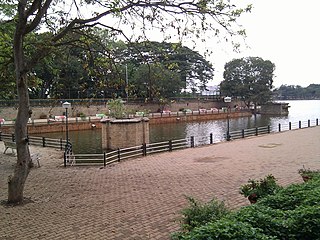
Sadashivanagara is an affluent residential neighbourhood in Bangalore in the Indian state of Karnataka. The neighbourhood houses plush homes and mansions of several famous celebrities, businessmen and politicians.
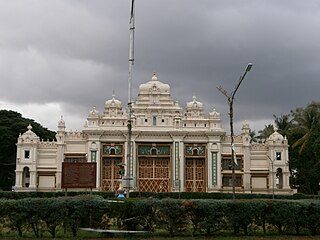
Jaganmohan Palace, officially Sri Jayachamarajendra Art Gallery, is a royal mansion, arts museum and auditorium, and formerly an alternative royal residence of the ruling maharaja of Mysore, located in Mysore, India, about 200m (600ft) to the west of Mysore Palace. Began in 1856 and completed in 1861, the palace is one of the oldest modern structures in Mysore.

The Rajendra Vilas is a palace-hotel atop Chamundi Hills in Mysore, Karnataka, India. It is now closed and in a state of neglect and can only be visited with prior permission.
Chamarajendra Academy of Visual Arts (CAVA) is a visual art school in Mysore, in the state of Karnataka in India. The academy is affiliated to the University of Mysore and offers courses in drawing, painting, sculpture, graphics, applied arts, photography and photo-journalism and art history. CAVA awards degrees in Bachelor of Fine Arts (BFA) and Master of Fine Arts (MFA).
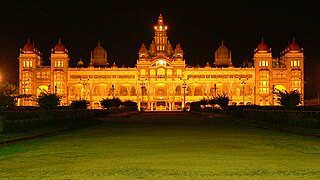
Mysore is a city in the state of Karnataka, India. It is known as the cultural capital of Karnataka. Mysore was the capital of the Wodeyar kings who ruled over the Mysore Kingdom for many centuries. Wodeyars were great patrons of art and music and have contributed significantly to make Mysore a cultural centre. Mysore is well known for its palaces, museums and art galleries and the festivities that take place here during the period of Dasara attract a worldwide audience. Mysore has also lent its name to popular dishes like Mysore Masala Dosa and Mysore Pak. Mysore is also the origin of the popular silk sari known as Mysore silk sari and has also given rise to a popular form of painting known as Mysore painting.
The antiquity of architecture of Karnataka can be traced to its southern Neolithic and early Iron Age, Having witnessed the architectural ideological and utilitarian transformation from shelter- ritual- religion. Here the nomenclature 'Architecture' is as old as c.2000 B.C.E. The upper or late Neolithic people in order to make their shelters, they constructed huts made of wattle and doab, that were buttressed by stone boulders, presumably having conical roof resting on the bamboo or wooden posts into red murram or paved granite chips as revealed in archaeological excavations in sites like Brhamagiri, Sanganakallu, Tekkalakota, Piklihal. Megaliths are the dominant archaeological evidence of the early Iron Age. There are more than 2000 early Iron Age burial sites on record, who laid the foundation for a high non-perishable architecture in the form of various distinct architectural styles of stone built burials, which are ritualistic in its character. The active religious architecture is evident 345 with that of the Kadamba Dynasty. Karnataka is a state in the southern part of India originally known as the State of Mysore. Over the centuries, architectural monuments within the region displayed a diversity of influences, often relaying much about the artistic trends of the rulers of twelve different dynasties. Its architecture ranges dramatically from majestic monolith, such as the Gomateshwara, to Hindu and Jain places of worship, ruins of ancient cities, mausoleums and palaces of different architectural hue. Mysore Kingdom (Wodeyar) rule has also given an architectural master structure in the St. Philomena's Church at Mysore which was completed in 1956, in addition to many Dravidian style architectural temples. Two of the monuments are listed under the UNESCO World Heritage List of 22 cultural monuments in India. Styles of Indo-Saracenic, Renaissance, Corinthian, Hindu, Indo-Greek and Indo-British style palaces were built in Mysore, the city of palaces. Sikh architecture at Bidar (1512) and also in Bangalore in 1956 can also be cited as having an impact on the architectural composition of the state.

The group of temples at the Amba Vilas Palace in Mysore were constructed during various periods by the kings of the Wodeyar dynasty who ruled the Kingdom of Mysore from about 1399 to 1947 A.D. These temples are protected monuments under the Karnataka state division of the Archaeological Survey of India.
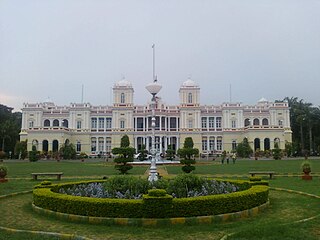
Cheluvamba Mansion is located in the city of Mysore, Karnataka. It was built by Maharaja Krishnaraja Wodeyar IV for the third princess of Mysore - Cheluvajammanni and it is similar to other mansions built by them which are spread over a large area surrounded by gardens. This mansion is crafted like other buildings of the Wadiyar dynasty.

Manasagangotri is a suburb of Mysore city in Mysore district of Karnataka state, India. Mysore University and its various departments are located in this area.

Chamaraja Road or Chamarajendra double Road is an important main street in downtown Mysore city, Karnataka state, India.
Mirza Road is a road in Mysore city, Karnataka state, India.
Jayalakshmipuram is an urban commercial and residential suburb of Mysore city in Karnataka state, India. Residence of Noted Kannada Poet Javaregowda is located in Jayalakshmipuram.